Walt Disney Pictures (October 5 1949), Walt Disney Home Video (October 3 2000), single disc, 68 mins plus supplements, 1.33:1 original full frame ratio, Dolby Digital Mono, Rated G, Retail: $19.99
Storyboard:
Disney’s two-part feature recounts the tales of two fabulous literary characters, Kenneth Grahame’s Mr Toad of The Wind In The Willows, and Washington Irving’s Ichabod Crane and The Legend Of Sleepy Hollow. Adding to the atmosphere are narrators Basil Rathbone and Bing Crosby, who bring their own unique quality to Mr Toad and Ichabod’s stories, respectively.
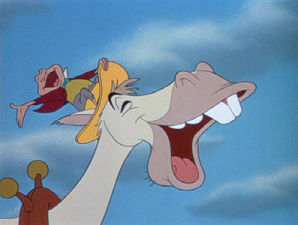
The Sweatbox Review:
Toward the end of the Second World War, Walt Disney wanted to put his animation company back on track and once again produce the full-length animated features the Studio had become famous for. The advent of the War had cut off the important international markets for his films, and after the blockbusting Snow White, returns for Pinocchio, Fantasia and Bambi had been disappointing. Dumbo, with its brisk pace, low budget and simple cartoon animation, had proved one bright spot during these troubled times and so the emphasis was placed on more stories like this. Live-action also provided a lower cost, faster turnaround type of production and so the “Package Feature” was created at the Studio.
First out of the gate was The Reluctant Dragon, which combined a live-action tour of the Studio with inserted animated featurettes. The traditional short cartoons made at the Studio at this time used the same talent as the feature animation department (artists often worked on the shorter films between features), so it was not that much of a stretch to put the feature animators and directors back on to the shorter styled cartoons. Many of the sequences that were created for these films were later issued as stand-alone shorts, and in many cases this was the only way of seeing these mini-masterpieces (the Studio would also, over time, stop producing the animated character shorts, but continue to create such one-off “specials” that might have otherwise ended up in package features such as these).
With the Studio strike of 1942, Walt was rushed out of the country on a “goodwill ambassadors” trip to South America, where he would gather new material for use in the next two films, Saludos Amigos (1943) and The Three Caballeros (1945). Walt’s time away allowed his brother Roy to settle the union arguments without his headstrong brother getting involved, but it also provided the opportunity for the South American films to provide new innovation, with their extended use of integrating live-action and animation wowing new audiences in those countries. These films were followed by the musical package features Make Mine Music (often called “the working man’s Fantasia”) in 1946, Fun And Fancy Free (the nearest Walt got to a full animated feature during these times) from 1947, and 1948’s Melody Time, which was merely little more than a compilation of musical and comedy featurettes.
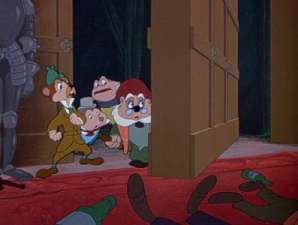
Disney also pushed for more live-action, and the 1946 feature The Song Of The South was a big step in this direction, featuring a strong narrative structure within which animated sequences were used to aid the story. The film remains Walt’s masterpiece from the 1940s, a technical and emotional tour de force that still amazes those who have seen it to this day. More importantly, James Baskett, the actor who plays storyteller Uncle Remus, was the first live-action star in a Disney film to win an Oscar! Song Of The South’s follow-up film, So Dear To My Heart (1949), featured even more live-action, and has often been named as Walt’s most favorite, personal film. With the War coming to an end, Walt found that much of his money from pre-War film releases was locked up in foreign territories and he was obliged to plough it back into productions in those countries. Before embarking on the British-shot, fully live-action Treasure Island (1950), So Dear To My Heart, with its two minimal animated song sequences, had proven the groundwork in setting up a crew that could handle the live-action features. But Walt knew that in order to survive he needed another Snow White, which had saved the Studio from bankruptcy a decade earlier.
Working back towards the idea of a full-length animated feature, a number of suggestions were brought forward. Many of them (Peter Pan, Alice In Wonderland, and The Sword In The Stone among others) would later become features themselves of course, but Walt was tied to doing another fairy-tale, and the story of Cinderella (which had been in development at the Studio since Snow White’s success) was given a green light. The feature department had by now fallen into the routine of going back to producing animated shorts for the package features, many of which were very “cartoony” in their execution. Walt felt a project that would act as a crossover back to detailed feature production was needed, and two stories that the Studio held rights to, The Legend Of Sleepy Hollow and The Wind In The Willows, were considered as full features. In the end, it was decided to merge these two unlikely bedfellows into one single feature, which would serve as the Studio’s official 11th animated film.
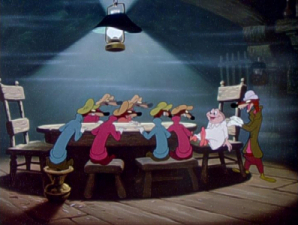
Opening with Mr Toad, a version of Kenneth Grahame’s novel The Wind In the Willows, the movie brings us into the magical and inspirational world of a library full of books. On the shelves, we see many stories that were under consideration at the Studio at the time until the camera rests on one, The Wind In The Willows. The book opens up, and introduces the warm tones of Basil Rathbone, whose very British voice lends itself well to the tale. Mr Toad himself is a gadget freak, always into the latest trends. Not long after he’s bought himself a horse and cart does he find himself lured toward owning a motorcar at any cost. His friends Rat and Mole try to talk him out of this flash in the pan desire, but Toad secretly makes a deal with the sly Weasels to swap his luxury home for a car. But when the Weasels double cross him and he becomes the prime suspect in a serious crime, Toad must go on the run to save himself and clear his name (or at least, until the next scrape he finds himself in)!
The story ends and the book readjusts itself on a shelf in the library. Here the narration is given over to Bing Crosby for Washington Irving’s legend of Ichabod Crane (recently retold in much more horrific style by Tim Burton), telling the tale with his inimitable bouncy and boomy vocals. Crosby has a couple of good tunes to sing here, not least the opener, in which we meet our “hero”, the reserved and slightly wispy Ichabod, the town’s new schoolteacher. He breezes into town, catching the eye of Katrina, a young lady looked on with affectionate eyes by Brom Bones, the local heavy. He definitely does not take a shine to Ichabod and tries to outwit him in every department. However, Ichabod has careful timing and clever tricks up his sleeve, and it’s only when Bones finds out about Crane’s superstitious nature that he decides to tell the perfectly scary tale of the Headless Horseman at a party in the town tavern. The story freaks Ichabod out so much that on his way home, he begins to hear things that may or may not actually be there…
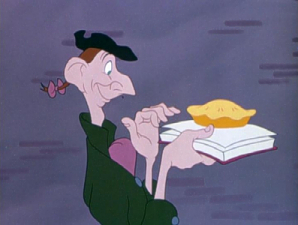
Both of the stories are handled extremely well, and the action chase sequences that close each “act” are well above average in pace and editing, rivalling the best of Disney and making for some very excitable movie-making. Rathbone’s voice on Mr Toad is superb, adding a sense of atmospheric “reality” to the tale and covering plot points that might have made scenes themselves in a longer, feature version of the story. Sleepy Hollow is likewise brought to life with knowing wit by Crosby, who brings a well-rounded feeling of Americana to the story that matches the British-ness that Rathbone brings to his English piece. This is also one of the only films from the Studio on which almost all of the Nine Old Men are credited together: six as directing animators, while others can be found amongst the additional supervising names.
The animation is up to the best of Disney, just bringing in the lush style that we would see from the Studio artists in the 1950s. Every detail is accounted for, and even seems to have inspired the animators of today: check out the Weasels from Mr Toad and their eventual reappearance as Judge Doom’s Toon Patrol in Who Framed Roger Rabbit; and the shadow-lit animation of Brom Bones telling his tales in the tavern certainly has more than a passing resemblance to Gaston’s Mob Song in Beauty And The Beast over 40 years later.

In fact what this film excels at is the animation of light and shadow, with some truly memorable imagery throughout (much of it again seemingly inspiring the makers of Beauty And The Beast, especially Ichabod’s heading into town). The chase scenes are especially vibrant in their execution, with a real tempo urging things forward, and the characters in real danger. Each is handled differently, with the creepiness and sparse orchestral sound of Sleepy Hollow (the Horseman’s laugh is the main sound used for effect here) a complete contrast to Mr Toad’s train escape, playing full on with guns blazing and the orchestral music score jauntily going for all its worth!
From the two sequences, it’s tough to pick a favorite, and it would be more than fascinating to have seen how they would have played the other way around. I’d only seen the films in their individual incarnations until their recent restoration into this original presentation, and together they make for interesting comparisons. Hollow is a very laid back, American story, while Willows revels in its very Englishness. But both sequences work together as well as they do apart, and picking “the best” is like asking which half of the same pie you’d like (and yes, I like my pie), though Hollow’s climax, played more for drama than Mr Toad’s laughs, is probably the more heart pounding and provides a fittingly exciting ending.
The film, in development, was originally named Two Fabulous Characters, and was the possible basis for a future series of films featuring more pairings. The Adventures Of Ichabod And Mr Toad was successful enough to allow Walt the green light for Cinderella, and although this signalled the end of the Package Features, a later episode of the DisneyLand TV series did compile a number of shorts in a show called Four Fabulous Characters.
Each segment of Ichabod And Mr Toad was issued on its own later in theatrical and television life, with the Mr Toad sequence undergoing the most releases, under the original title The Wind In The Willows, as well as The Madcap Adventures Of Mr Toad, and The Adventures Of J Thaddeus Toad Esq! In the late-1990s, Disney tried to turn the tale into a live-action adventure directed by Monty Python’s Terry Jones (and featuring a few of the Pythons in starring roles) but the experiment was not too successful on any front. At this time there are plans to bring the story to the screen once again, but for my money, it was nailed the first time, in this charming feature.
Is This Thing Loaded?
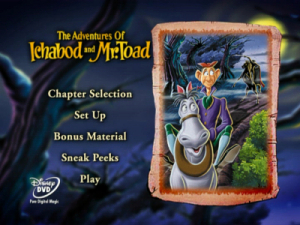
As these two stories continue to be made available as separate films, one might think that having the other half of the film as a whole could be counted as an extra in itself! However, this really is the way Walt wanted to introduce these characters to animation, and it’s great to finally see the complete movie as was intended. The DVD adds a number of bonus features, none of which are as particularly interesting as they might have been.
When the disc plays for the first time, we’re pointed toward the usual Disney Sneak Peeks (all viewable again from the menu and skipable on this first playing). On this disc, there are previews for a string of sequels: the Buzz Lightyear series pilot, Lady And The Tramp II, Toy Story 2 and Fantasia/2000.
The Legend Of Sleepy Hollow DVD storybook replays the second half of the feature as an interactive on-screen “book” that kids can have read to them, or read in their own time. The pre-recorded version, lasting a good six-minutes, is actually pretty fun, with music and sound from the film mixed in to good effect.
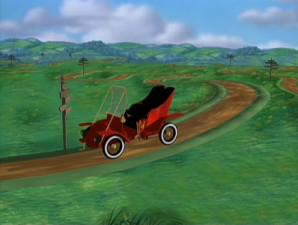
On a disc that promotes the Sleepy Hollow segment much more than its Wind In The Willows sequences (the cover and the menus are distinctly Ichabod-themed) it’s nice to have a sing-along song included that promotes Mr Toad’s side of things (although oddly, there are no words onscreen to sing along to)! The Merrily Song, sung by Toad and his horse Cyril Proudbottom, is also repeated on the Mr Toad’s Wild Ride game, a question and answer quiz based on facts from the film.
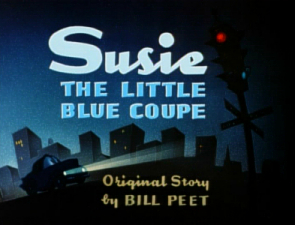
This disc even has a secret up its sleeve: as a bonus for winning the Mr Toad game, you’ll be treated to the 1952 featurette Susie The Little Blue Coupe, narrated by Sterling Holloway. It’s a great short, very much in the style of the 1940s and 50s films, but this might have been more appropriate on one of the other Package Feature releases. No matter, as it’s nice to see a childhood favorite again anyway.
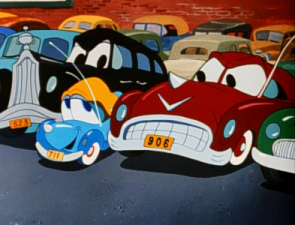
Also available elsewhere, the best of the added material is the 1938 Mickey Mouse short Lonesome Ghosts. Included presumably due to its primarily ghostly-connections, the print on display here has not been cleaned up by any restoration, and those looking to add this classic cartoon to their collections would be best to seek out the Mickey Mouse In Living Color special edition tin set in the Walt Disney Treasures line.
In rounding the disc up, I’d love to say that the later and thematically similar Four Fabulous Characters TV special has been included, but it isn’t, and we’re also missing a trailer. When it comes to any DVD-ROM additions it also looks as if the Headless Horseman has made off with them, or else Mr Toad has given them away to the Weasels – there aren’t even any links included, except for a back-cover prodding to visit the Disney Videos site. All in all, there’s not a very varied selection of goodies, but some thought has been put into the games and at least a decent reward for winning, with the Suzie short, is offered. The real joy of this disc, though, is to own both stories in their original feature-length version just as Walt intended.
Case Study:
Traditionally, Disney titles have always been issued in white cases, from the special clamshells of the VHS days and continuing on with these Gold Collection releases on DVD. As mentioned above, the cover art leans heavily towards the Sleepy Hollow segment, even if much more wonderful publicity art from the time must have been readily available. Mr Toad gets a little more space on the back, and on the inside chapter insert, where the same image is used three times. The insert’s reverse plays up the interactive aspects of the game and storybook.
Ink And Paint:
Presented with its original RKO Distributors card intact, this is as close as fans will get to seeing Walt’s 11th animated film in its original form. The colors are good, if a little muted, and the detailed artwork looks stunning. Print-wise, things aren’t so rosy, with nicks and scratches appearing around each reel change during the film. Still, I’ve never seen a better print than this, and one can not expect the Studio to carry out an extensive restoration on all of its “lesser” features (or this one anytime soon), so it’s as good as it’s going to get.
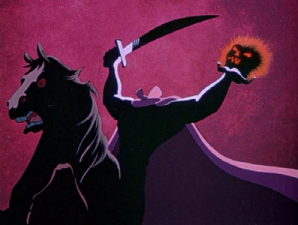
The overall enjoyability of the film and its characters soon overcomes any shortcomings the quality may have, although the print transfer used here is noticeably a little sharper than the LD, with no over use of edge enhancement or digital artefacts creeping in. A clean looking disc, if not helped by the dated print, which is just beginning to show its age.
Scratch Tracks:
Making up for any shortcomings in the picture department, the audio is as crisp and clean as any pre-surround sound mono track I’ve heard. Rathbone and Crosby’s voices come through well and the mix is very well handled. The music score, supervised by Disney stalwart Oliver Wallace, features some memorable tunes, which buzz around one’s head for days, and is reproduced here with nice dynamics. Turn up the bass woofer a bit and you’ll get a nice punch in the action sequences too! French and Spanish dubs are included and even go so far as to have different narrative voices tell each story, and there is an additional English subtitle track.
Final Cut:
It’s a sad fact that until recently these two stories were often seen only in their separated featurette-length versions (indeed, the Sleepy Hollow segment is available only on its own in Region 2 territories). The film was finally restored and released as it should have been seen in the mid 1990s on a limited, no frills LaserDisc edition, though this DVD does it much more justice. As a purist, I’d recommend seeing The Adventures Of Ichabod And Mr Toad in this, its original intention, although both sequences do work on their own. It’s the perfect movie to watch in two halves, and younger kids may want to exit the film before the scarier Sleepy Hollow segment kicks in after the first act. One feels that the original Two Fabulous Characters title may have been the better choice in describing the movie, but overall the designs, style (by, among others, Mary Blair) and concept behind the feature works well enough, and it simply ends up being an enjoyable film and very exciting entertainment!
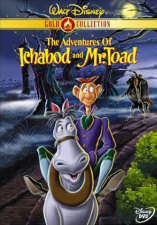 | ||
 |








